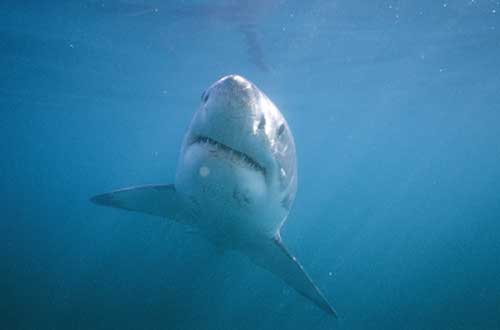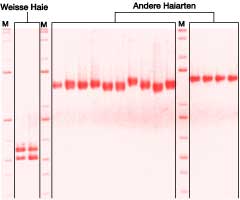|
Report by Shark Info

|
White sharks (Carcharodon carcharias) belong
to the most endangered shark species, still they are hunted for their
meat which lands on the world's fish markets.
© Klaus Jost / Shark foundation
|
|
The white shark (Carcharodon carcharias) is one of the best
protected shark species worldwide. Its name appears on the Red List
of the IUCN (International Union for Conservation of Nature) under
the "most vulnerable" species (Category A1bcd + 2cd). With CITES it
is still on Appendix III which calls for close observation of any
trade with white sharks, although efforts are being made by
Australia and the U.S. to have it put on Appendix I, a list of
animals and plants which are directly endangered by extinction.
Trade with species found on Appendix I is prohibited worldwide,
except for scientific reasons.
Nevertheless, despite all efforts to protect white sharks, the
effective implementation of protective measures on the level of
international trade has proven to be extremely problematic.
Primarily this is because it is still almost impossible to prove
that trade with white sharks even takes place. This is especially
true in regions where, in addition to white sharks, other near
relative species which do not enjoy protection are traded, making it
insuperably difficult to identify shark meat, fins or already
processed trunks. Shark protectors and customs observers obviously
do not only encounter this problem with sharks but instead with all
protected species whose sister species can be traded.
Meanwhile, in his laboratory at Nova University, Daniela Beach,
Florida, Professor Mahmood Shivji developed a simple method of
determining whether or not tissue samples stem from white sharks.
The method can also be successfully used to check if parts of white
sharks have been processed in a mixture of different shark species,
e.g. in cartilagenous mixtures.
For several years Dr. Shivji has been working in the area of
molecular biological analysis and shark identification. The Shark
Foundation recognizes the importance of his research work for shark
protection and has been supporting him since 2000.
Up until now, Dr. Shivji has worked on identifying various,
commercially used shark species using minute tissue samples. Thanks
to his molecular biological methods – which we reported on in
our article "Molecular biology helps protect sharks" (
Shark Info
1/2000) – 16 different shark species can now be identified.
Although these methods are sufficiently reliable for statistical
analyses on catches and scientific research, a bitter fight is being
waged in international trade. This means that any test methods must
be doubly and triply reliable if they are to be recognized by
international courts.
The new method developed by Dr. Shivji's laboratory functions with
five probes in one single step (Pentaplexer PCR Test) and will more
likely meet these requirements.
While the "simple" method only looks at one especially appropriate
gene, the new method of identifying white sharks includes the same
analysis of a base sequence of the cell nucleus plus a mitochondrial
gene in one step. Since it makes use of DNA variations in two cell
organelles, it is also called the Bi-organelle Test. Its reliability
is further increased by an additional reaction which makes it
possible to determine if a provable reaction even took place.

|
The so-called agarose gel-elektrophoresis technique
makes reaction products of the B-organelle PCR tests visible. This method allows
clear identification of white shark tissue based on its band pattern.
© Mahmood Shivji / Shark Foundation
|
|
Furthermore, Dr. Shivji extensively scrutinized the Bi-organelle
Test. First, he had to prove that the proper recognition sequences
were selected from the white shark's genetic material. The sequences
would have to be specifically for white sharks, but not so specific
as to only recognize certain white shark populations. Dr. Shivji
thus took tissue samples from 53 white sharks stemming from all
ocean regions, all of which were positively recognized by the test.
In a second step he had to determine if the test was specific enough
to differentiate white sharks from its close relatives. In actual
practice this has proven to be the crux of the problem where the
greatest possibility exists of mistaken identification. So Dr.
Shivji tested four additional species from the Lamnidae family:
mackerel sharks (Lamna nasus), shortfin macos (Isurus oxyrinchus),
longfin macos (Isurus paucus) and salmon sharks (Lamna ditropis).
Once again the results were positive, being specific enough to
differentiate between the white shark's close relatives.
For implementation in the fishing industry, the test had to be
extended to other shark species, especially those from the orders of
the mackerel sharks (Lamnifores) and the ground or whaler sharks
(Carcharhiniformes) which represent the most common commercially
fished shark species, as well as – to be on the safe side
– diverse species from other orders.
For this purpose DNA from various shark species was mixed and the
mixture tested using the new method of establishing proof. Results
were again successful, showing a highly specific positive result
only in cases where the DNA mixture contained remnants of white
sharks.
All in all 68 different shark species were tested. In all cases the
Bi-organelle Tests fulfilled each reliability requirement.
Finally, even financial aspects play a substantial role when it
comes to species protection. Dr. Shivji's test requires no special
reagents or laboratory installations apart from the average standard
equipment found in the normal biochemical laboratory. Through its
high specificity 10 samples can be analyzed simultaneously in only
one test tube and with only one set of the relatively expensive
reagents.
These results are expected to be published shortly in a scientific
journal. When this happens, CITES, as well as other organizations
involved in shark protection such as the FAO (Food and Agricultural
Organization), will have at their disposable a valuable aid to
identify white sharks. By removing their basis of argumentation, it
will take the wind out of the sails of nations who until now have
opposed protecting white sharks, claiming they were not identifiable
in trade.
The easy-to-use application of bi-organelle tests also enables
large-scale monitoring of commodities in which parts of white sharks
are presumed.
Although initially the bi-organelle test for white sharks will most
likely only be applied by nations who have already placed white
sharks under protection, it still has the potential of being
implemented worldwide as soon as white sharks enjoy global
protection. A recent attempt on the part of CITES nations to put
white sharks on Appendix II of the CITES lists failed at least
partly because no reliable and economical methods were available to
identify products made from protected sharks.
In the future this very reliable and easy-to-use technique of
bi-organelle, pentaplex PCR tests can be adapted to protect other
animal and even plant life and so serve to control global trade with
these species.
May be published only by indicating the source: Shark Info
|


